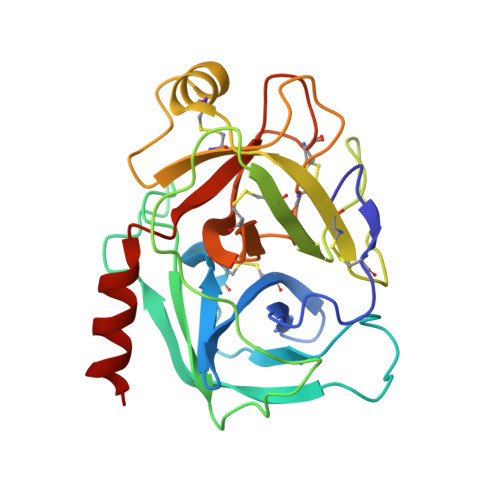Small molecule inhibitors of mesotrypsin from a structure-based docking screen.
Kayode, O., Huang, Z., Soares, A.S., Caulfield, T.R., Dong, Z., Bode, A.M., Radisky, E.S.(2017) PLoS One 12: e0176694-e0176694
- PubMed: 28463992
- DOI: https://doi.org/10.1371/journal.pone.0176694
- Primary Citation of Related Structures:
5TP0 - PubMed Abstract:
PRSS3/mesotrypsin is an atypical isoform of trypsin, the upregulation of which has been implicated in promoting tumor progression. To date there are no mesotrypsin-selective pharmacological inhibitors which could serve as tools for deciphering the pathological role of this enzyme, and could potentially form the basis for novel therapeutic strategies targeting mesotrypsin. A virtual screen of the Natural Product Database (NPD) and Food and Drug Administration (FDA) approved Drug Database was conducted by high-throughput molecular docking utilizing crystal structures of mesotrypsin. Twelve high-scoring compounds were selected for testing based on lowest free energy docking scores, interaction with key mesotrypsin active site residues, and commercial availability. Diminazene (CID22956468), along with two similar compounds presenting the bis-benzamidine substructure, was validated as a competitive inhibitor of mesotrypsin and other human trypsin isoforms. Diminazene is the most potent small molecule inhibitor of mesotrypsin reported to date with an inhibitory constant (Ki) of 3.6±0.3 μM. Diminazene was subsequently co-crystalized with mesotrypsin and the crystal structure was solved and refined to 1.25 Å resolution. This high resolution crystal structure can now offer a foundation for structure-guided efforts to develop novel and potentially more selective mesotrypsin inhibitors based on similar molecular substructures.
Organizational Affiliation:
Department of Cancer Biology, Mayo Clinic Comprehensive Cancer Center, Jacksonville, Florida, United States of America.

















